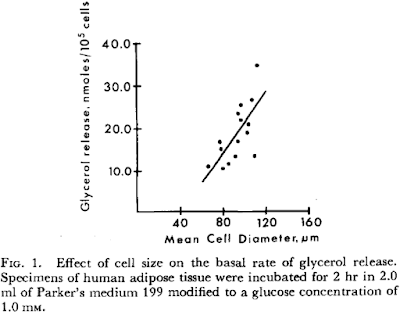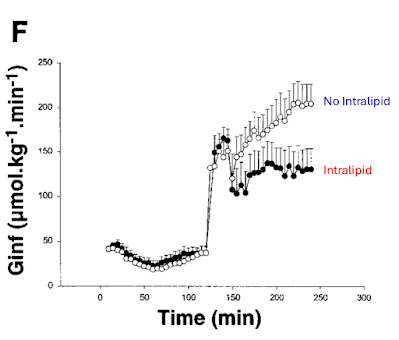Tucker emailed me this paper while I was writing the last post:
This section of Figure 5 superficially appears to confirm all of my biases. Respiration supported by lipid oxidation generates more ROS from D12942 fed mice than chow fed mice.
Except that's not a question I would have asked. These are cells in very specific cell culture conditions and the white and black bars are both from cells being "fed" on exactly the same concentration of palmitoyl-CoA. Theoretically the ROS production should be the same, given the same fatty acid. Plenty from palmitate, a little less from linoleate.
But here the question they asked is about cells extracted from a mouse exposed to D12942 for a week versus those from a mouse exposed to chow for a week and now both are currently being exposed to an identical level of palmitate.
It's very probable that the D12942 derived cells have more mtETFdh complexes than chow fed and that these complexes generate more ROS than cells from mice fed chow. We'll never know because they measured levels of complexes I, II, III and V, but not the complex delivering the primary lipid-derived FADH2 input to the ETC, mtETFdh. Go figure.
However.
When you read the methods section you realise they are not looking at physiology at all. These are not cells fed on simple substrates and then the ROS production is being measured. They are cells whose ETC chain is fully inhibited at the ATP synthase level by oligomycin at 6.7μg/ml. That is a solid inhibitory level. So, essentially, they are "pressurising" the ETC to a high membrane potential using succinate (10mM, also not a low level) and then looking at the ROS leakage under these conditions as the test substrate is applied, in addition to the succinate. The mtETFdh complex is famous for ROS generation under high membrane potential in far-from-physiological preparations.
This is interesting but has absolutely nothing to do with physiology and certainly gives no information about fatty acid mediated ROS generation at low physiological mitochondrial membrane potential. The whole point of ROS generation from fatty acid oxidation is that it does NOT require an elevated membrane potential.
Aside: Red flag warning. They also looked at ROS generation under state 3 respiration conditions, in which the cell preparation is flooded with ADP, which allows ATP synthase to dissipate membrane potential while forming ATP, so reduces ROS generation, which it did. Here outlined in red from section C of Figure 5:
But you can't dissipate membrane potential through complex V using ADP when that complex V is 100% blockaded by 6.7μg/ml of oligomycin. ADP only consumes membrane potential when ATP synthase is active. Flooding a cell preparation with a generous supply of ADP when ATP synthase is inhibited by oligomycin *should* generate zero uncoupling, so there will still be an high membrane potential and high ROS production. Yet ADP clearly reduces ROS generation in this model. I cannot see why this should be the case. It shouldn't.
I think the word is "dodgy". End aside.
So I'm not exactly overwhelmed by their permeabilised cell ROS generation model. It tells us nothing about in-vivo physiology.
The MCAT part of the study is even worse, in it's own way. These are real live mice which have been engineered to produce human catalase in their mitochondrial matrix (in addition to their own catalase) and they do show a marked preservation of insulin sensitivity when fed on D12942.
This is reported as a Good Thing.
They are tinkering with the second core physiological messenger, H2O2, (the first messenger is superoxide and this should be unaltered by catalase) within the mitochondrial matrix, and you would expect this to cause detectable physiological (or pathological) changes.
On chow it doesn't. They used a 10% of energy from fat chow and, not surprisingly, the reduction in mitochondrial matrix H2O2 had no measurable effect on insulin sensitivity. There is no need for grossly detectable physiological insulin resistance when only 10% of dietary calories are coming from fat. Insulin signalling preservation is an essential net benefit here.
The knock-in mice demonstrated some effects in some adipose depots under D12942 feeding, rendering them apparently less resistant to insulin's ability to phosphorylate AKT than they should be, ie more like chow fed mice. I have a 10 slide PowerPoint deck dissecting the problems with their data presentation, which I will spare you. But ultimately the effect is much smaller than presented but it is still present. Mostly.
What we actually want to know is whether the decrease of the normal ROS signal from FAO in the MCAT knock-in mice makes them behave as if they have an inadequate ROS signal, as mice fed 18% linoleate do. Do they get *extra* obese on D12942?
We don't know.
MCAT mice on low fat chow don't have any change to their insulin sensitivity compared to wild type. They have a normal, very carbohydrate based metabolism which requires minimal insulin resistance at low mitochondrial membrane potential.
Wild type mice on a 60% fat diet should, excepting the linoleate effect (which is initially huge), resist insulin and stay slim, they should be soourcing 60% of their calories from fatty acid oxidation and limiting the rump of their calorie generation from the small amounts of carbohydrate and protein in D12942. MCAT mice, like linoleate fed mice, shouldn't.
It would be nice if MCAT mice on D12942 became "hyperphagic" as wild type mice do for a few days, but then kept it up for the full week and beyond, until their adipocytes simply became so full that they were damaged and releasing those inflammatory mediators that long term D12942 fed WT mouse adipocytes eventually produce. You might even pick this up in weight gain changes at one week, the MCAT mice on D12942 should be fatter than the wild type mice on D12942.
I guess the alternative is that the overlay of PKCε and Thr1150 might kick in to rescue matters, which would limit the excessive insulin sensitivity of the MCAT mice. And would be boring. Hard to say, but of PKCε is under redox control then this route to salvation won't happen.
Sadly we'll never know about the weight gains. Despite the mice being weighed at the one week mark their weights are not reported.
As far as I can find no one else has fed MCAT mice on D12942 or its equivalent. They
do very well long term on an unspecified chow diet but that is both expected and very, very different to feeding D12942.
Overall the paper turned out to be hugely disappointing. C’est la vie.
Peter





































